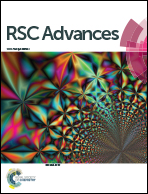High luminescent core–shell QDs based on noninjection synthesized CdSe QDs: observation of magic sized CdSe quantum dots†
Abstract
CdSe QDs have been synthesized via a noninjection approach using ODE as the solvent, Se powder and Cd(SA)2 as the raw materials. Under optimized conditions, magic-sized CdSe QDs were observed, which showed an uncommon continuous growth at low temperatures. The growth kinetics of the CdSe QDs was studied using UV-vis absorption and photoluminescence spectroscopy. The results indicate that the dissolution of Se powder limited the starting point and the rate of nanocrystal nucleation. Comparative studies validated that the growth of QDs in the noninjection synthesis approach showed distinctly different kinetic features from those synthesized by the traditional hot-injection route. In addition, the changes of the Cd/Se feed molar ratio primarily influence the nucleation moment of the QDs, thus they control the particle size. The as prepared CdSe QDs were of high quality with a photoluminescence quantum yield (PL QY) of 34%. After passivating with ZnS, the PL QY increased to 63%. Moreover, with an additional ZnSe transition layer between the ZnS shell and CdSe core, the QY reached as high as 74%, which was comparable with the QY of QDs obtained by the hot-injection route.


 Please wait while we load your content...
Please wait while we load your content...